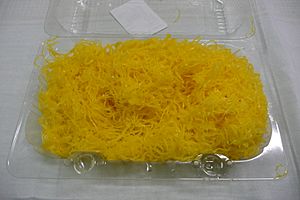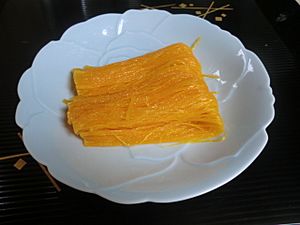Fios de ovos facts for kids

Foi thong in Thailand
|
|
| Alternative names | Angel hair |
|---|---|
| Type | Dessert |
| Place of origin | Portugal |
| Main ingredients | Eggs (chiefly yolks), sugar syrup |
Angel hair, also known as Fios de ovos in Portuguese (meaning "egg threads"), is a sweet treat from Portugal. It is made from eggs, mostly the yolks. These yolks are turned into very thin strands and then cooked in a sweet sugar syrup.
This dessert is a traditional part of both Portuguese and Brazilian food. In Brazil, it can be used in desserts or as a side dish with savory meals.
Fios de ovos has different names around the world:
- In Spain, it's called Huevo hilado ("spun egg").
- In Japan, it's known as Keiran Somen ("hen's egg noodle").
- In Cambodia, it's Vawee.
- In Malaysia, it's Jala mas ("golden net").
- In Thailand, it's Foi Thong ("golden strands").
- In the North Malabar region of Kerala, India, it's called Muttamala ("egg lace").
Contents
History of Fios de Ovos

Many egg-based sweets from Portugal, including fios de ovos, were likely created by nuns. This happened around the 14th or 15th centuries. Convents and monasteries often did laundry. They used egg whites to "starch" clothes, which made them stiff. This left them with many extra egg yolks.
The recipe for fios de ovos probably traveled to Japan and Thailand. Portuguese explorers brought it there between the 16th and 18th centuries.
Fios de Ovos in Brazil
In Brazilian cooking, fios de ovos is used in special cakes. One famous cake is the bolo Marta Rocha. This cake is named after Miss Brazil 1954, Martha Rocha. It has layers of vanilla and chocolate sponge cake. It is topped with whipped cream, fios de ovos, and sometimes cherries or nuts.
It is also used to decorate torta de nozes. This is a layer cake with walnut sponge. It is filled with doce de ovos, which is an egg custard. The cake is finished with meringue and fios de ovos.
Fios de Ovos in Thailand
In Thailand, fios de ovos is called Foi Thong. This name means "golden strands." It is called this because it looks like fine, long, shiny threads, similar to silk. It is considered a very special dessert.
The word Thong means "gold," which is a lucky color for Thai people. The long strands also stand for a long life and never-ending love. A woman named Maria Guyomar de Pinha brought fios de ovos from Portugal to Thailand. She is sometimes called the "Queen of Thai desserts." Foi Thong is often served at important ceremonies.
Fios de Ovos in Japan
In Japan, Fios de ovos is known as Keiran Somen. The Matsuyariemon restaurant has made its special Keiran Somen for 13 generations. They have been making it since 1673. This dessert is one of the nanbangashi. These are sweets that came from Portugal during the Nanban trade period. The recipe has been a very closely guarded secret. It is passed down from one generation to the next.
This Keiran Somen is often cut into small pieces. These pieces are then wrapped with a line of seaweed. This version is called Keiran Somen Tabane. The 12th generation leader of Matsuyariemon created this idea. It makes the dessert easy to eat. Its beautiful shape is perfect for chanoyu (tea ceremony). Keiran Somen Tabane is a fancy sweet that makes a great gift.
How Fios de Ovos is Used
In Portugal and Brazil, fios-de-ovos are often used in different ways. They can be fillings inside cakes or other desserts. They are also used as decorations on top of cakes. In Brazil, they are sometimes served with savory dishes. For example, they might be served with canned fruits alongside Christmas turkey.
In Japan, they are served as dessert rolls called wagashi. They are known there as keiran sōmen (鶏卵素麺, egg yolk thin noodles).
See also
 In Spanish: Huevo hilado para niños
In Spanish: Huevo hilado para niños


